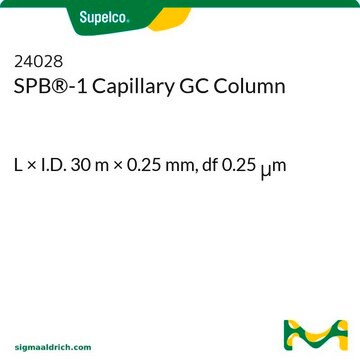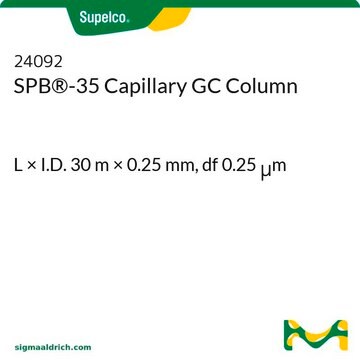25351
SPB®-5 Capillary GC Column
L × I.D. 60 m × 0.53 mm, df 5.00 μm
About This Item
Produtos recomendados
Materiais
fused silica
Nível de qualidade
Agency
meets requirements for USP G27 and G36
Parâmetros
-60-260 °C temperature (isothermal)
-60-280 °C temperature (programmed)
Valor beta
27
df
5.00 μm
técnica(s)
gas chromatography (GC): suitable
C × D.I.
60 m × 0.53 mm
Grupo ativo da matriz
Bonded; poly(5% diphenyl/95% dimethyl siloxane) phase
tipo de coluna
capillary non-polar
Procurando produtos similares? Visita Guia de comparação de produtos
Categorias relacionadas
Descrição geral
USP Code: This column meets USP G27 and G36 requirements.
Phase:
- Bonded
- Poly(5% diphenyl/95% dimethyl siloxane)
- ≤0.32 mm I.D., <2 μm: -60 °C to 320 °C (isothermal or programmed)
- ≤0.32 mm I.D., ≥2 μm: -60 °C to 300 °C (isothermal or programmed)
- ≥0.53 mm I.D., <2 μm: -60 °C to 300 °C (isothermal) or 320 °C (programmed)
- ≥0.53 mm I.D., ≥2 μm: -60 °C to 260 °C (isothermal) or 280 °C (programmed)
Aplicação
Outras notas
Informações legais
Código de classe de armazenamento
11 - Combustible Solids
Classe de risco de água (WGK)
WGK 3
Ponto de fulgor (°F)
Not applicable
Ponto de fulgor (°C)
Not applicable
Escolha uma das versões mais recentes:
Já possui este produto?
Encontre a documentação dos produtos que você adquiriu recentemente na biblioteca de documentos.
Active Filters
Nossa equipe de cientistas tem experiência em todas as áreas de pesquisa, incluindo Life Sciences, ciência de materiais, síntese química, cromatografia, química analítica e muitas outras.
Entre em contato com a assistência técnica




